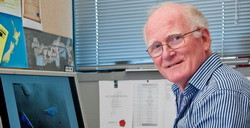Two Wellington health researchers have been jointly awarded the prestigious Liley Medal for their outstanding contributions to health and medical science at New Zealand’s top research honours awards.
Cell biology expert Professor Mike Berridge (pictured right) from the Malaghan Institute of Medical Research and intensive care specialist Dr Paul Young from Capital & Coast District Health Board and the Medical Research Institute of New Zealand (MRINZ) both received a Health Research Council of New Zealand (HRC) Liley Medal at the Royal Society of New Zealand’s Research Honours Dinner in Christchurch this evening.
This is the first time since 2008 that the HRC Liley Medal has been awarded to two people in the same year. The decision to award two medals was made because the researchers’ studies, while very different, were considered equally important in terms of potential impact.
Professor Berridge was one of the lead researchers in a landmark paper that demonstrated for the first time the movement of mitochondrial DNA between cells in an animal tumour model.
This new transfer to tumour cells, which was published in the high impact biological journal Cell Metabolism last year, showed that after mitochondrial DNA was removed from mouse models of breast cancer and melanoma, replacement mitochondrial DNA was gathered from surrounding normal tissue. After adopting this new DNA, the cancer cells then went on to form tumours that spread to other parts of the body.
Professor Berridge says that he and his research colleague An Tan were expecting tumour growth but were surprised when they found the tumour cells contained mitochondrial DNA from surrounding cells.
“Our initial response was that these cells must have slowly adapted to growing without mitochondrial DNA. When we detected mitochondrial genes in the tumour cells, we thought we had made a mistake, while reviewers of earlier manuscripts thought we must have had some residual mitochondrial DNA in the cells we were using,” says Professor Berridge.
“With the help of our overseas collaborators, we were able to build a solid case for mitochondrial gene transfer between cells and have now shown that it involves the transfer of whole mitochondria.”
HRC Chief Executive Professor Kath McPherson says Professor Berridge and his team’s novel discovery, partly funded through a HRC Explorer Grant that supports transformative research at an early stage, challenges core ideas in science, and opens up new fields for understanding normal human physiology and disease.
“This discovery could offer significant insights into the evolution and spread of cancerous tumours. It also lays important groundwork for understanding human diseases other than cancer, since defective mitochondrial DNA accounts for about 200 diseases and is implicated in many more, including neurodegenerative and neuromuscular disorders,” says Professor McPherson.
Dr Paul Young received his Liley Medal for leading the HRC-funded SPLIT trial, the largest clinical trial ever conducted exclusively in New Zealand intensive care units (ICUs) and the highest impact study in the field of intensive care medicine for 2015.
Published in the Journal of the American Medical Association (JAMA), the SPLIT trial compared the effectiveness of the two most commonly used intravenous fluid therapies for intensive care patients – saline solution and a newer alternative fluid with lower chloride concentrations called Plasma Lyte®.
The study, which was designed by Dr Young and fellow frontline ICU doctors, was in response to recent data suggesting that saline solutions may increase the risk of patients developing kidney failure.
Dr Young says the study showed that the two fluids had similar outcomes, and that using saline did not increase the risk of developing kidney failure compared with using Plasma Lyte®.
“The results are of major significance for global public health because they provide reassurance about the safety of intravenous saline, which is currently administered to more than a million patients around the world every day,” says Dr Young.
“Saline is also cheaper than the newer fluids like Plasma Lyte® by between 50 cents and eight dollars, depending on the country, so this study also has the potential to lead to health care cost savings of millions of dollars every day on a global scale.”
Dr Young says outcomes for ICU patients in New Zealand are among the best in the world, and he hopes this award will highlight to clinicians from other disciplines just what can be achieved through collaborative research.
“I’d like to acknowledge the help and support I’ve received on this study from ICU specialist colleagues from around the country, from the hundreds of ICU nurses who cared for the patients, to the ICU research coordinators who did the real work, and the MRINZ coordinating centre staff. Most of all, I’d like to thank all the patients who participated in the study.”
HRC Chief Executive Professor Kath McPherson says Dr Young’s study, which was coordinated by MRINZ, involved 2,278 patients from four New Zealand ICUs. Remarkably, she says, it was completed in 28 weeks of active recruitment at a cost of $200,000 and yet is likely to save millions of dollars for New Zealand and health systems globally, making it an excellent return on investment.
“Paul and his team’s findings from this study are currently the best evidence that exists in this field and will likely have major implications for health care delivery and the management of ICU patients in New Zealand and around the world,” says Professor McPherson.
“Despite Paul being involved in research for only six years, he’s already achieved so many impressive outcomes with the support of the Australian and New Zealand Intensive Care Society Clinical Trials Group. He’s currently leading six HRC-funded studies, including a HRC-funded trial to find out if saline or Plasma Lyte® leads to a lower risk of death in the sickest ICU patients, and he was just last month awarded a HRC clinical practitioner research fellowship to look into the prevention and treatment of fever in the ICU.”
